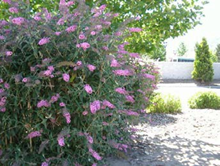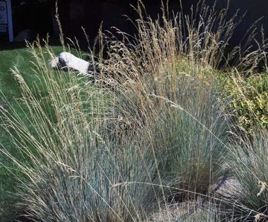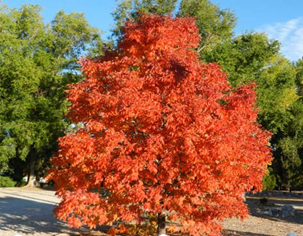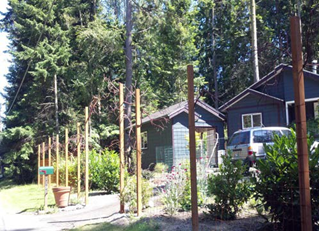Deer-Resistant Plants for Northern Nevada
JoAnne Skelly
Extension Educator Carson City, University of Nevada
Introduction
Deer can wreak havoc on a garden or landscape. Gardeners are always looking for deer-resistant plants. In a perfect world, there would be plants that deer would definitely not eat. However, a sufficiently hungry deer will find almost any plant palatable. Which plants a deer eats in one yard may be different from those a deer eats in another yard. Deer are browsers, eating primarily the growing tips of shrubs, trees and other plants. They may eat young plants but ignore those same plants when they are more mature.
Which plants are supposedly deer resistant?
Sunset Western Garden Book (2012) lists the following plants (in black) as deer- resistant. Local nurseries anecdotally suggest additional plants that they find are often deer-resistant (in gray). There is no guarantee that these plants won’t be eaten. The Sunset editors write, “Deer in different areas may have different tastes,” so be cautious when trying out these plants in northern Nevada. Deer may eat some species in each of these groups and not others. Only plants suitable for northern Nevada’s climate are included in the following lists. However, not all members of a group are hardy in northern Nevada, so when deciding on plants, do further research on specific species to find out their climate hardiness (http://planthardiness.ars.usda.gov/PHZMW eb/), water requirements, and soil and light needs. The scientific name is in parenthesis after the common name for accurate identification.
Where only the first part of the scientific name (genus) is listed, multiple species in that genus may be deer-resistant. When both the genus and species name are listed, only that particular plant is deer- resistant. Others in the genus may be eaten by deer. Be aware that many of the plants on the list are poisonous to people and pets.
Rutgers University compiled an extensive list that rates landscape plants by their deer resistance based on input from nursery and landscape professionals, Rutgers New Jersey Agricultural Experiment Station, Cooperative Extension personnel and Master Gardeners: http://njaes.rutgers.edu/deerresistance/.
Many of the plants listed by Sunset Western Garden Book are mentioned by Rutgers and are noted in the list. Some are rarely damaged (A), some seldom damaged (B), some occasionally damaged (C) and a few frequently damaged (not included in the list). This illustrates that plant lists are subjective when it comes to deer resistance. While not all the plants for New Jersey will survive northern Nevada’s dry sunny winters, others could work well in a landscape here.
Perennials
aster (Aster)B
autumn crocus (Colchicum)A
bee balm (Monarda)B
black-eyed Susan (Rudbeckia)B
blanket flower (Gaillardia x grandiflora)C
bluebell (Scilla)
campion (Lychnis)
candytuft (Iberis)B
catchfly (Silene)
catmint (Nepeta)A
columbine (Aquilegia)B
common snowdrop (Galanthus nivalis)
coreopsis (Coreopsis)B
cornflower (Centaurea)
cranesbill (Geranium)
crocus (Crocus)B
crown-pink (Lychnis coronaria)
crown imperial fritillaria (Fritallaria imperialis)
daffodil (Narcissus)A
daylily (Hemerocallis)C
euphorbia (Euphorbia)
false spiraea (Astilbe)
fleabane (Erigeron)
foxglove (Digitalis)
gloriosa daisy (Rudbeckia hirta)
grape hyacinth (Muscari armeniacum)B
hardy geranium(Geranium)B to D
hellebore (Helleborus)
hyssop (Hyssopus officinalis)A
hummingbird flower (Zauschneria californica)
hummingbird mint (Agastache)
iris (Iris) A
Jupiter’s beard (Centranthus ruber)
lady’s mantle (Alchemilla)
lavender (Lavendula) A
lungwort (Pulmonaria)
lupine (Lupinus)B
milkweed (Asclepias)
mint (Menthe)A
monkshood (Aconitum)A
moss pink (Phlox subulata)
obedient plant (Physostegia virginiana)
oregano (Origanum vulgare)
ornamental onion (Allium)
penstemon (Penstemon)C
peony (Paeonia)A
phlomis (Phlomis)
phlox (Phlox)C
pincushion flower (Scabiosa – some)B
pink (Dianthus)B
poppy (Papaver)
purple coneflower (Echinacea purpurea) B
red-hot poker (Kniphofia)B
sage (Salvia)
santolina (Santolina)A
self-heal (Prunella)
Serbian bellflower (Campanula poscharskyana)
skullcap (Scutellaria)
snowdrop (Galanthus)
snowflake (Leucojum)
soapwort (Saponaria)B
speedwell (Veronica)B
sweet violet (Viola odorata)
thrift (Armeria) B
triteleia (Triteleia grandiflora)
verbena (Verbena)
wallflower (Erysimum)
windflower (Anemone)
yarrow (Achillea) B
Shurbs or Shrub-Like
barberry (Berberis)A
boxwood (Buxus)A
butterfly bush (Buddleja)A
cotoneaster (Cotoneaster)B
currant (Ribes)B
daphne (Daphne)
elaeagnus (Elaeagnus)B
buckwheat (Eriogonum)
firethorn (Pyracantha)B
flowering quince (Chaenomeles)
heavenly bamboo (Nandina domestica)
heath (Erica)
holly (Ilex)
juniper (Juniperus)B
kerria (Kerria japonica)
kinnikinnick (Arctostaphylos)
lilac (Syringa)B
Oregon grape (Mahonia)A
pieris (Pieris)
potentilla (Potentilla)A
rhododendron (Rhododendron)
Russian sage (Perovskia atriplicifolia)A
Siberian carpet cypress (Microbiota decussata)A
smokebush (Cotinus)B
spiraea (Spiraea)B
snowberry (Symphoricarpos)B
St. Johnswort (Hypericum)B
sumac (Rhus)A
viburnum (Viburnum)A to B
weigela (Weigela)B
wormwood/sagebrush (Artemesia)

Groundcovers and Vines
blue fescue(Festuca glauca)A
bugloss (Brunnera macrophylla)B
calamint (Calamintha)
carpet bugle (Ajuga)A
English ivy (Hedera helix)C
epimedium (Epimedium)
feather grass (Stipa)
fountain grass (Eriogonum)A
Japanese spurge (Pachysandra terminalis)B
lamb’s ear (Stachys byznatina)A
periwinkle (Vinca)B
rockcress (Arabis)
sandwort (Arenaria)
saxifrage (Saxifraga)B
snow-in-summer (Cerastium tomentosum)B
sweet woodruff (Galium odoratum)A
switch grass (Pancium virgatum)A
thyme (Thymus)
wisteria (Wisteria)B

Groundcovers and Vines
ash (Fraxinus)B
cedar (Cedrus)
cypress (Cupressus)
fir (Abies)C
hackberry (Celtis)
hawthorn (Crataegus)B
maidenhair tree (Ginkgo biloba)
maple (Acer)B to C
oak (Quercus)C
pine (Pinus)B
spruce (Picea)B (dwarf AlbertaA)
western redbud (Cercis occidentalis)

Introduction
Planting a landscape with plants less appetizing to deer is a great beginning to deer-proofing a yard. However, fencing and exclusionary tactics are the only consistently effective tools to ensure that deer stay away from plants. Not just any fence will do. An 8-foot fence, a double offset fence, a slanted seven-wire fence or an electric fence are recommended.
Fencing has to be properly constructed. University of Nebraska Cooperative Extenison’s “Prevention and Control of Wildlife Damage” has excellent directions for building fences to keep out deer http://icwdm.org/handbook/index.asp#di.
If fencing is not an option, individual plants can be protected with woven wire cages. Scare tactics, such as dogs or motion- sensitive sprinklers, only provide temporary relief. As soon as the dog or the water spray is gone, the deer return.

A wide variety of repellants is available. Colorado State University Extension’s publication “Preventing Deer Damage” includes a table rating a variety of deer repellants by their relative effectiveness. Some repel by smell, others by taste. Some are applied directly to plants, while others are applied over an area. Area repellants are usually less effective than contact ones. Dormant application of repellants is sometimes recommended. Since regular applications are required, costs can be high and effectiveness is variable. Rainfall can reduce the benefits of a repellant. Repellants reduce damage, but rarely eliminate it. If a deer is hungry, bad taste or strong odor won’t keep it away from plants.
Another tactic is planting desired species inside a ring of plants unpalatable to deer.
Damage to plants by deer will vary with seasons, food availability in their natural habitat, water availability and fluctuations in deer populations. Combining deer-resistant plants, fencing, other exclusionary tactics and repellants will provide the best plant protection.
Resources
Brenzel, K.N. 2012. The New Sunset Western Garden Book. Time Home Entertainment Inc.
Cornell University, Clemson University, University of Nebraska-Lincoln and Utah State University. 2005. Prevention and Control of Wildlife Damage. Online at: http://icwdm.org/handbook/index.asp#di.
New Jersey Agricultural Experiment Station. 2014. Landscape plants rated by deer resistance. Online at: http://njaes.rutgers.edu/deerresistance/.
Swift, C.E. and M.K. Gross. 2008. Colorado State University Extension No. 6.520. Preventing Deer Damage. Online at: http://www.ext.colostate.edu/pubs/natres/06520.html
